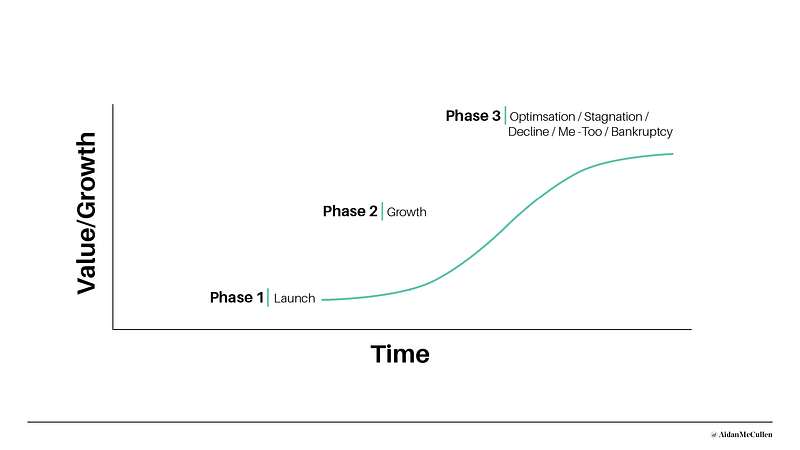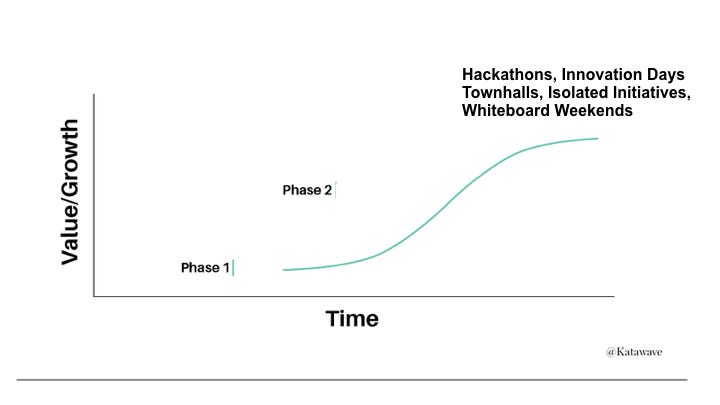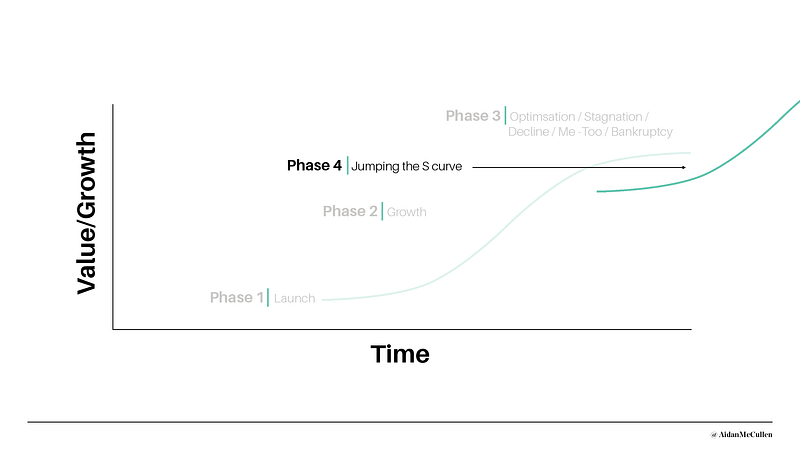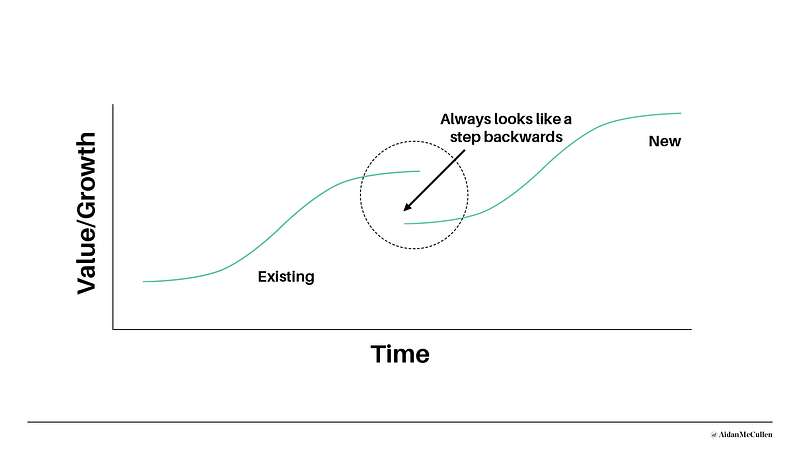
“It took me 17 years and 114 days to become an overnight success” — Lionel Messi
Maxwell Maltz was an American cosmetic surgeon and author of Psycho-Cybernetics, which was a system of ideas that he claimed could improve one’s self-image. During his studies, he observed the pattern that after cosmetic surgery like a nose job it took a patient about 21 days to get used to seeing their new face. This gave rise to the myth that it takes 21 days to form a habit.
For those of us who have struggled to stay on a diet, keep a gym regime or finish reading that book we know it takes much longer than 21 days.
[Insert Buzzword Here]
In a business environment of mass disruption, many businesses feel they need to have “innovation” on their agenda. This is often a reactive response to a board action “What are we doing about [insert buzzword here]?”. To show board solidarity and not admit no-one really knows much about [insert buzzword here] everyone nods in agreement. A board action is taken to do something about [insert buzzword here] for the next board meeting.
Buzzwords include Gig Economy, Sharing Economy, Circular Economy, Bitcoin, Blockchain, Crypto Currencies, Peer-2-Peer, Future of Work, Disintermediation, Decentralisation, Ai, AGI, Machine Learning, IoT, Data, Big Data, GDPR and for those very far behind: digitisation.
Innovation Splashes
Many well-intentioned companies decide to take action on the innovation agenda. The default action is to run a hackathon (splash), have an innovation day (splash) or have a company-wide town hall meeting with an excellent keynote speaker to announce innovation is now on the agenda.
These initiatives are not wrong as part of an engineered process. However, in isolation such initiatives are ineffective. They are akin to going to the gym for a few days and then reverting to type.
When you go to the gym for a few days, you get a great spike of endorphins, dopamine, serotonin and oxytocin, but when you stop so does the rush.
When you run an innovation splash you get a spike of endorphins, dopamine, serotonin and oxytocin, but when you stop so does the rush. When you stop you return to the day job. For the innovation team or instigator of the innovation initiative they think they had made huge progress, excited everyone and that the innovation event was going to change mindsets. Unfortunately, it was only a splash and the splash soon dissipates.
We must realise and respect that people are rarely measured on tomorrow, they are both measured and incentivised on today. Weekly, Monthly, Quarterly and Yearly results govern our actions. It is only the extremely successful companies who assign time to the long-term plan, the vision, the North Star of the company.
Failed Splashes and Corporate Nose Jobs
Most business transformations fail. Much more achievable than a business transformation is a digital transformation. However, according to this recent survey by Fujitsu on a global scale organisation experience failed digital initiatives to the tune of €555,000. In Ireland, 20% have experienced a failure costing €831,500.
‘You may have the brightest and most progressive people, but they will flounder in a culture that stifles innovation’ — Tony O’Malley
Maxwell Maltz was a recognised cosmetic surgeon, but he realised that his true calling was to change how people thought about themselves. Cosmetic surgery was a signal that they wanted to change, but it was not the answer. Mental surgery would mean true transformation.
“The ‘’self-image’’ is the key to human personality and human behavior. Change the self image and you change the personality and the behavior.” — Maxwell Maltz
S(plash) Curves
I wrote about S Curves a couple of weeks back, but here is a quick reminder.
S curves are a great way to map both business and product life-cycles. S curves follow the shape of the letter S with a shallow start with early adopters and niche clientele. Rapid growth comes next, followed by a dominant position in the market.

After the rapid growth, businesses or products plateau and experience stagnation, process optimization, automation job cuts and quite often a “me-too” proposition.

Running isolated initiatives like innovation “days”, hackathons etc. are top of the S curve splashes. They are signals of an attempt to rise above a me-too proposition, they are a signal that the people in an organisation want to change, they need change. Leaders should address a bigger question when they see such initiatives. When leaders witness this, it signals the need for a meaningful organisational direction and a significant change.
Next S Curve “Ripples”

To truly innovate companies and leaders need to jump from one S curve to another, but few have the courage to do so. The jump will always like a step backwards, it has to, the next jump is not established, it will be messy like any new business, but it can be sense checked, it can be run through a process to see if it is “in flow”.
This jump needs a leader who embraces a constant “S curve jump” mentality.

A Ripple not a Splash
Digitisation of broken models, AR/VR for the sake of AR/VR, an app for the sake of an app or any isolated digital, innovation or change initiative will be just that: isolated. As we have seen from countless surveys and countless initiatives they will fail unless they are connected to an organisational direction.
Why do organisations continue to paper over the cracks?
Changing mindsets is so much slower and more painful than creating new products. It is easier to create new products. It is easier to be busy developing new products than question why you are doing so in the first place.
The hardest thing is to change mental models, but innovation and transformation in an established organisation are about changing mental models and not just business models.
Changing mindsets is a gradual change and oftentimes, hard to quantify. Innovation leaders within traditional organisations need to show progress so they partake in tangible outputs to show progress, even if it is disconnected from an overarching purpose.
Old leadership styles and mentalities will question the output of change initiatives because it seems intangible for such a long time.
The leader of today recognises that when the organisation is aligned in purpose they will reach deeper into their discretionary effort and drive the organisation to success. When 31% is the minimum discretionary effort
Innovation is a process, not just a plan. Change at any level takes time, Jim Collins refers to this as the flywheel, to get it started takes a huge effort, it takes step-by-step action, many many decisions, some good, some bad. It takes heartache, it takes persistence, it takes discipline and patience. It means tactfully managing short-term goals and long-term thinking. Above all it takes direction and it takes leadership.
There is no miracle moment when it comes to change.
True change is a ripple and never a splash.
Thanks for reading, please hit like so the LinkedIn algorithm puts this post in front of other people.
On this week’s innovation show EP 60: Bitcoin, Blockchain, Explained, Explored, we talk to Dominic Frisby actor, writer for MoneyWeek, presenter and author of the excellent “Life after the State”, “Let’s Talk about Tax” and “Bitcoin”. While Bitcoin is around since the financial crisis, it is misunderstood. Dominic gives us a jargon-free history of the origins of Bitcoin. He also tells us where it is headed and how so many industries will be disrupted. As always, these industries are late to react, while Dominic tells us “The horse has bolted”.
If you want to understand Bitcoin and Blockchain this is well worth a listen.